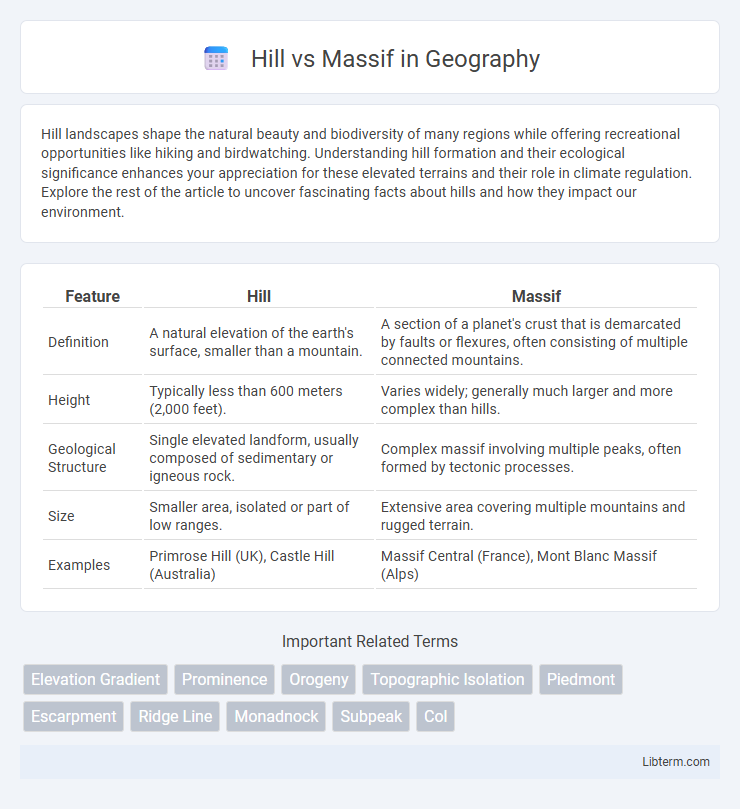Hill landscapes shape the natural beauty and biodiversity of many regions while offering recreational opportunities like hiking and birdwatching. Understanding hill formation and their ecological significance enhances your appreciation for these elevated terrains and their role in climate regulation. Explore the rest of the article to uncover fascinating facts about hills and how they impact our environment.
Table of Comparison
| Feature | Hill | Massif |
|---|---|---|
| Definition | A natural elevation of the earth's surface, smaller than a mountain. | A section of a planet's crust that is demarcated by faults or flexures, often consisting of multiple connected mountains. |
| Height | Typically less than 600 meters (2,000 feet). | Varies widely; generally much larger and more complex than hills. |
| Geological Structure | Single elevated landform, usually composed of sedimentary or igneous rock. | Complex massif involving multiple peaks, often formed by tectonic processes. |
| Size | Smaller area, isolated or part of low ranges. | Extensive area covering multiple mountains and rugged terrain. |
| Examples | Primrose Hill (UK), Castle Hill (Australia) | Massif Central (France), Mont Blanc Massif (Alps) |
Understanding the Concepts: Hill vs Massif
A hill is a natural elevation of the earth's surface with a distinct summit, typically smaller and less steep than a mountain, often formed by erosion or tectonic activity. A massif refers to a large, compact group of connected mountains or a section of the earth's crust that has moved as a single unit, often featuring multiple peaks and extensive geological complexity. Understanding the distinction involves recognizing that hills are individual landforms of modest height, whereas massifs represent extensive geological structures consisting of numerous interconnected mountain masses.
Geological Formation Differences
Hills are typically formed through processes like erosion, sediment deposition, or tectonic uplift, resulting in smaller elevation changes with gentler slopes. Massifs, on the other hand, are large, compact blocks of the Earth's crust that have been uplifted or displaced by faulting, often composed of resistant rock types such as granite or metamorphic rock, and exhibit significant structural coherence. The key geological difference lies in their formation mechanisms: hills often result from surface processes, while massifs are primarily shaped by deep tectonic forces and maintain extensive, stable rock mass integrity.
Elevation and Size Comparison
Hill elevations typically range from 100 to 600 meters, while massifs generally exceed 600 meters, often reaching several thousand meters in height. In terms of size, massifs cover extensive mountainous regions with complex geological structures, whereas hills occupy smaller, less rugged areas with gentler slopes. The significant difference in elevation and spatial extent distinguishes massifs as prominent landforms compared to more modest hills.
Landscape Features and Appearance
A hill is a naturally elevated landform with a rounded, gentle slope typically rising less than 600 meters above the surrounding terrain, often covered in grass or small vegetation. A massif, on the other hand, is a compact group of connected mountains or a large section of the Earth's crust that appears as a block, featuring rugged, steep slopes and prominent rock formations. Hills generally blend smoothly into the landscape, while massifs create dramatic, imposing features that dominate their surroundings.
Distribution Around the World
Hills are found globally across diverse climates, often forming the gentle rises prevalent in temperate and tropical regions, while massifs primarily occur in mountainous zones with complex geological formations, such as the European Alps, Himalayas, and Andes. Distribution of massifs is concentrated in tectonically active regions where crustal blocks have been uplifted and isolated, contrasting with hills that frequently appear as erosion remnants or sediment deposits. Geographic prevalence shows hills dominate lowland and upland terrains worldwide, whereas massifs are more localized to specific mountainous belts, reflecting distinct earth crust processes.
Ecological Significance
Hills support diverse plant and animal species due to their moderate elevation and varied microclimates, promoting ecological niches that contribute to regional biodiversity. Massifs, often comprising extensive mountainous terrain, serve as critical watersheds and climate regulators while harboring endemic species adapted to high altitudes. Both formations play pivotal roles in soil conservation and carbon sequestration, underscoring their ecological significance in sustaining environmental balance.
Human Habitation and Usage
Hills generally support diverse human habitation due to their moderate slopes and fertile soils, enabling agriculture, settlements, and infrastructure development. Massifs, characterized by their rugged terrain and higher elevations, often limit extensive human usage but serve as key sites for mining, forestry, and mountain tourism. Both landforms influence local climate and water resources, shaping patterns of human activity and urban planning.
Hill and Massif in Popular Culture
Hills often symbolize tranquility and simplicity in popular culture, frequently depicted as idyllic settings in literature, films, and art, embodying themes of peace and isolation. Massifs, characterized by their massive, rugged formations, are commonly portrayed as formidable natural barriers or mystical landscapes in fantasy genres and adventure narratives. Both landforms influence cultural symbolism, with hills representing gentle beauty and massifs evoking strength and endurance.
Notable Examples Globally
Notable examples of hills include the Malvern Hills in England and the Salisbury Hills in Australia, recognized for their moderate elevation and ecological significance. Massifs, characterized by large, compact mountain sections, include the Mont Blanc Massif in the Alps and the Harz Massif in Germany, known for their geologic stability and complex topography. These formations serve as critical landmarks and attract scientific research due to their unique geological and environmental features.
Key Takeaways: Choosing the Right Term
Choosing between "hill" and "massif" depends on size, geological formation, and context; a hill is a naturally raised area of land, smaller and less complex than a massif. Massifs are large, compact groups of connected mountains, often formed by tectonic forces, representing significant geological structures. Understanding these distinctions aids in accurate geographic description and scientific communication.
Hill Infographic

 libterm.com
libterm.com